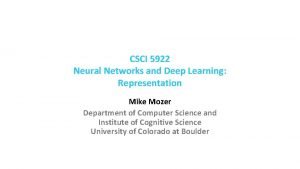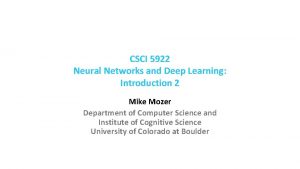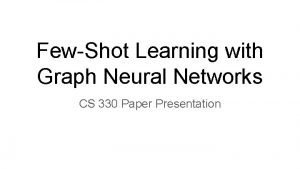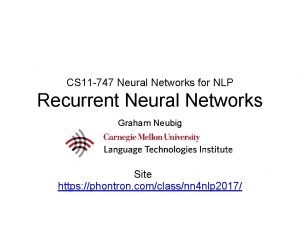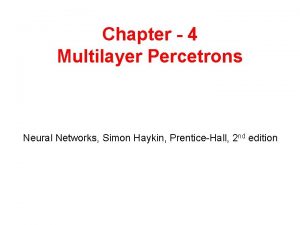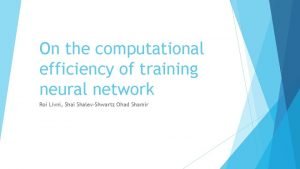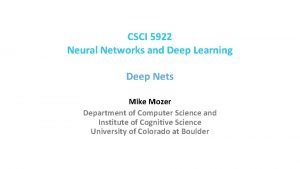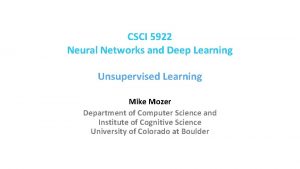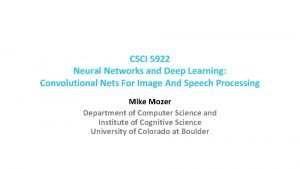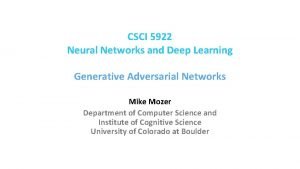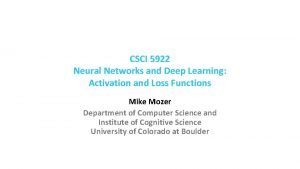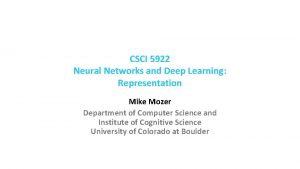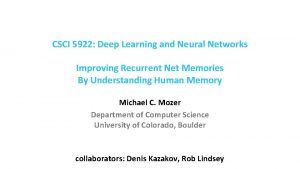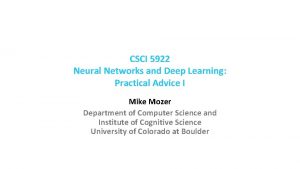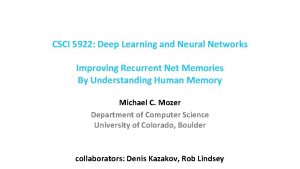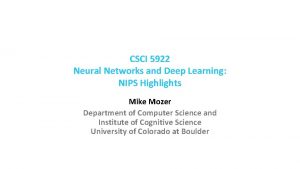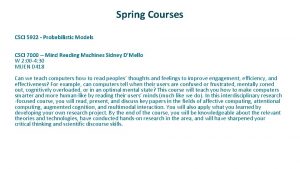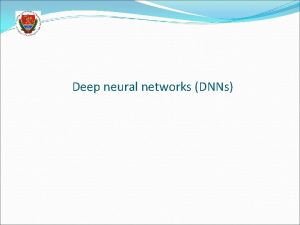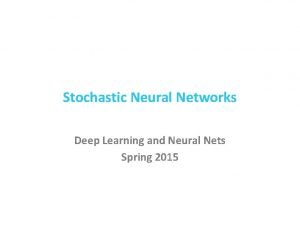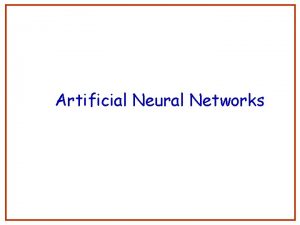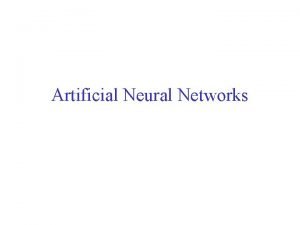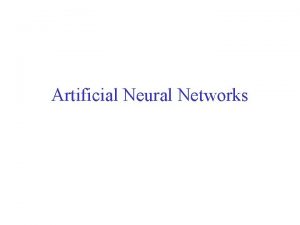CSCI 5922 Neural Networks and Deep Learning Deep

























- Slides: 25

CSCI 5922 Neural Networks and Deep Learning Deep Nets Mike Mozer Department of Computer Science and Institute of Cognitive Science University of Colorado at Boulder

Why Stop At One Hidden Layer? ü E. g. , vision hierarchy for recognizing handprinted text Word output layer Character hidden layer 3 Stroke hidden layer 2 Edge hidden layer 1 Pixel input layer

From Ng’s group

Why Deeply Layered Networks Fail ü Credit assignment problem § How is a neuron in layer 2 supposed to know what it should output until all the neurons above it do something sensible? § How is a neuron in layer 4 supposed to know what it should output until all the neurons below it do something sensible?

Deeper Vs. Shallower Nets ü Deeper net can represent any mapping that shallower net can § Use identity mappings for the additional layers ü ü Deeper net in principle is more likely to overfit But in practice it often underfits on the training set § Degradation due to harder credit-assignment problem § Deeper isn’t always better! ü CIFAR-10 Image. Net thin=train, thick=valid. He, Zhang, Ren, and Sun (2015)

Why Deeply Layered Networks Fail Vanishing gradient problem § With logistic or tanh units § Error gradients get squashed as they are passed back through a deep network gradient ü layer

ü gradient Why Deeply Layered Networks Fail layer

ü Using Re. LUs § can avoid squashing of gradient Hack Solutions layer ü Use gradient clipping § for exploding gradients ü Use gradient sign § for exploding & vanishing gradients

Hack Solutions ü Hard weight constraints § avoids sigmoid saturation for vanishing gradients § may prevent gradients from blowing up by limiting error gradient scaling

Hack Solutions ü

Hack Solutions ü

Hack Solutions ü Unsupervised layer-by-layer pretraining § Goal is to start weights off in a sensible configuration instead of using random initial weights § Methods of pretraining autoencoders restricted Boltzmann machines (Hinton’s group) § The dominant paradigm from ~ 2000 -2010 § Still useful today if not much labeled data lots of unlabeled data

Autoencoders ü ü Self-supervised training procedure Given a set of input vectors (no target outputs) Map input back to itself via a hidden layer bottleneck How to achieve bottleneck? § Fewer neurons § Sparsity constraint § Information transmission constraint (e. g. , add noise to unit, or shut off randomly, a. k. a. dropout)

Autoencoder Combines An Encoder And A Decoder Encoder

Stacked Autoencoders . . . copy ü deep network Note that decoders can be stacked to produce a generative domain model

Restricted Boltzmann Machines (RBMs) ü

Depth of Image. Net Challenge Winner source: http: //chatbotslife. com

Trick From Long Ago To Avoid Local Optima ü ü Add direct connections from input to output layer Easy bits of the mapping are learned by the direct connections § Easy bit = linear or saturating-linear functions of the input § Often captures 80 -90% of the variance in the outputs ü Hidden units are reserved for learning the hard bits of the mapping § They don’t need to learn to copy activations forward for the linear portion of the mapping ü Problem § Adds a lot of free parameters

Latest Tricks ü Novel architectures that § skip layers § have linear connectivity between layers ü Advantage over direct-connection architectures § no/few additional free parameters

Deep Residual Networks (Res. Net) ü activation flow He, Zhang, Ren, and Sun (2015)

Res. Net ü kklk He, Zhang, Ren, and Sun (2015)

Res. Net Top-1 Error % He, Zhang, Ren, and Sun (2015)

A Year Later… ü Do proper identity mappings He, Zhang, Ren, and Sun (2016)

Highway Networks ü Srivastava, Greff, & Schmidhuber (2015)

Highway Networks Facilitate Training Deep Networks Srivastava, Greff, & Schmidhuber (2015)
 Csci 5922
Csci 5922 Csci 5922
Csci 5922 Deep forest: towards an alternative to deep neural networks
Deep forest: towards an alternative to deep neural networks Deep neural networks and mixed integer linear optimization
Deep neural networks and mixed integer linear optimization Efficient processing of deep neural networks pdf
Efficient processing of deep neural networks pdf Least mean square algorithm in neural network
Least mean square algorithm in neural network Neural networks and learning machines
Neural networks and learning machines Few shot learning with graph neural networks
Few shot learning with graph neural networks Visualizing and understanding convolutional networks
Visualizing and understanding convolutional networks Neural networks for rf and microwave design
Neural networks for rf and microwave design Fuzzy logic lecture
Fuzzy logic lecture Tony wagner's seven survival skills
Tony wagner's seven survival skills Vc dimension neural network
Vc dimension neural network Localization of function ib psychology
Localization of function ib psychology Audio super resolution using neural networks
Audio super resolution using neural networks Convolutional neural networks for visual recognition
Convolutional neural networks for visual recognition Leon gatys
Leon gatys Introduction to convolutional neural networks ppt
Introduction to convolutional neural networks ppt Pixel recurrent neural networks.
Pixel recurrent neural networks. Introduction to neural networks using matlab
Introduction to neural networks using matlab 11-747 neural networks for nlp
11-747 neural networks for nlp Perceptron xor
Perceptron xor Sparse convolutional neural networks
Sparse convolutional neural networks On the computational efficiency of training neural networks
On the computational efficiency of training neural networks Tlu neural networks
Tlu neural networks Netinsights
Netinsights
